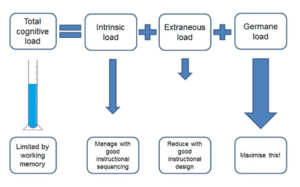This has come about as a result of a meeting at CLEAPSS with a chemistry teacher from Norfolk, David Paterson. https://dave2004b.wordpress.com/
Greater details are given in an article he wrote for Education in Chemistry (https://eic.rsc.org/feature/making-practical-work-more-effective/3008027.article)
“To understand chemistry, students need to work at three levels. These are, the macroscopic level (observations), the sub-microscopic level (particles), and the symbolic level (equations). This is known as Johnstone’s Triangle.
As relative experts, teachers have internalised the differences and connections between these levels, and can easily switch between them. Students, as novices, have to contend with all three levels, often at once, without understanding the links between the ideas we are presenting. Simply put, they can find chemistry overwhelming.
Cognitive Load Theory (CLT) offers an explanation for students’ struggles. Originally developed by educational psychologist John Sweller in the 1980s, CLT attempts to explain the cognitive processes related to learning, and develop strategies to increase the likelihood of students learning effectively.
The basis of CLT is that memory is divided into
working memory, which has a very limited capacity, and
long-term memory, which is effectively limitless.
We learn by taking in information from our environment and deriving meaning from it by connecting it with what we already know (ie what is stored in our long term memory).
CLT identifies three broad categories of thinking, or cognitive loads.
 Cognitive overload occurs if the total cognitive load exceeds the working memory
Cognitive overload occurs if the total cognitive load exceeds the working memory
Intrinsic thinking derives meaning from new information and how it is connected.
Extraneous thinking involves dealing with information not related to what you’re learning and
Germane thinking is building mental models (or schema) that encode the meaning of the information and how it is connected.”
To try to combat this, David has been adapting some of the practical activities he use with various classes to integrate the diagrams and the textual instructions into ‘integrated-instructions’.
I have adapted a few of these too.
Animated Instructions
Dave’s instructions are static sheets designed, I assume, to be handed out as paper. The move to online learning during the lockdown set me to thinking how this approach could be made electronic. The answer is to use the built-in features of powerpoint to animate them.
A first effort can be found here: Animated ppt Instructions



